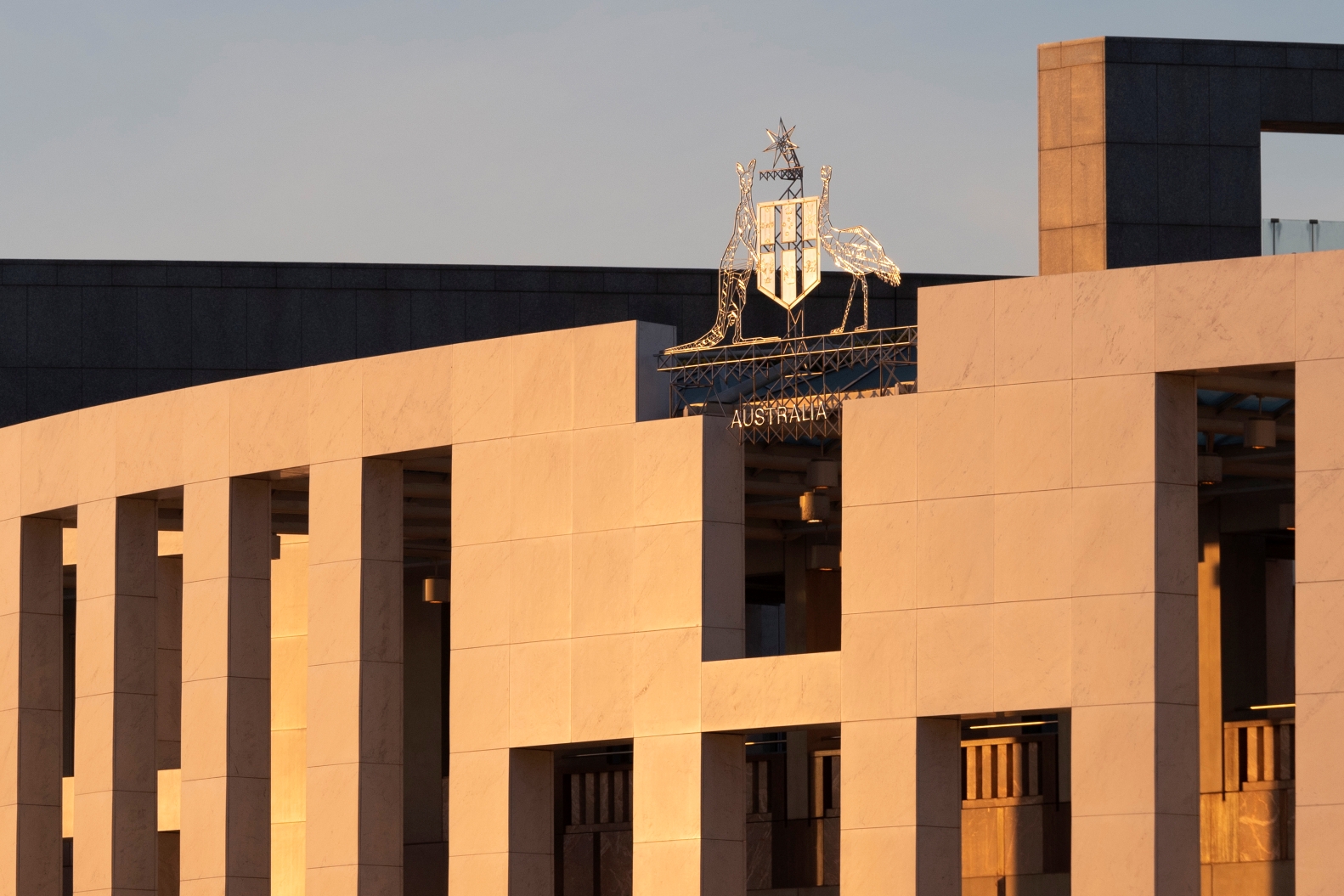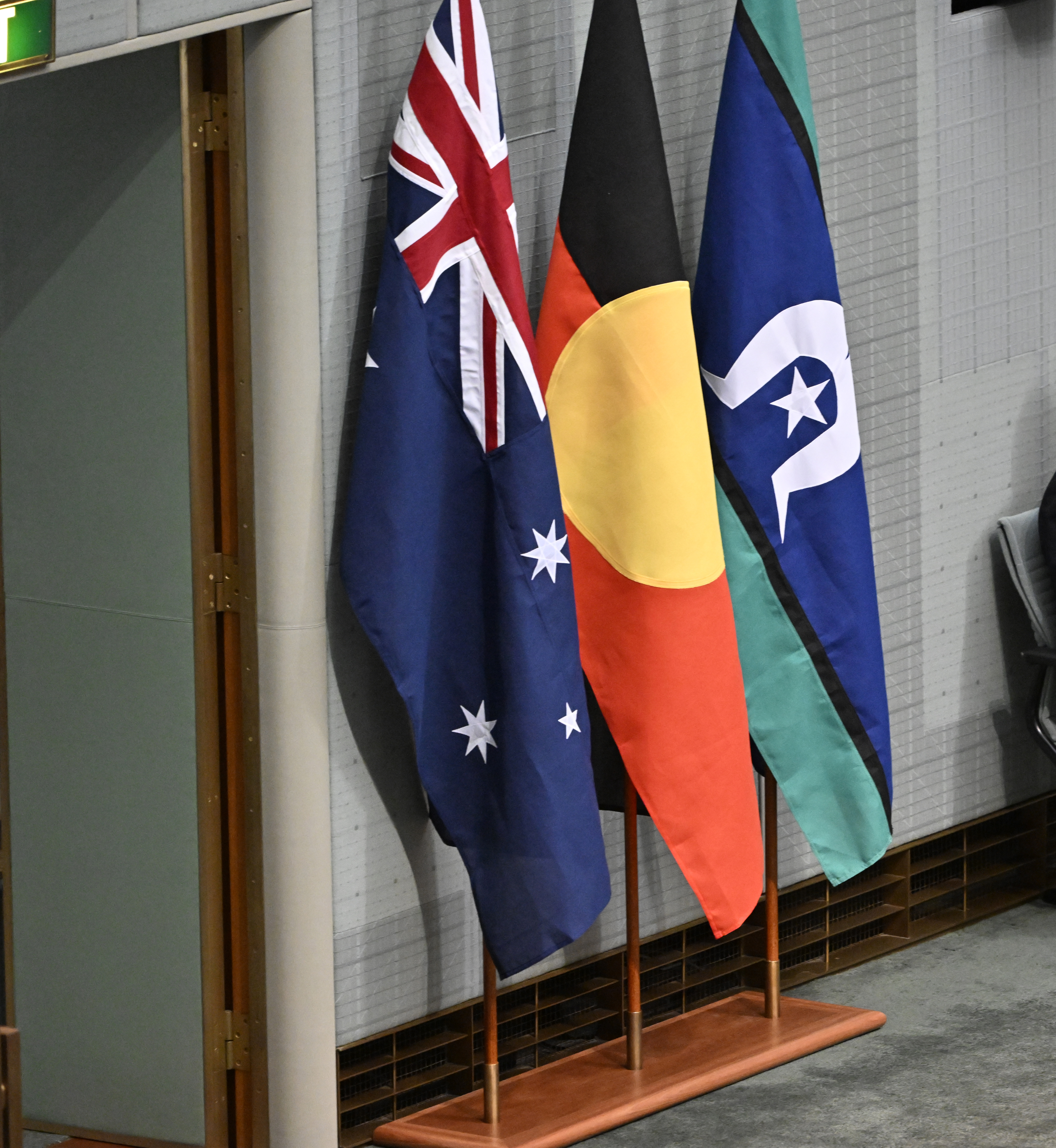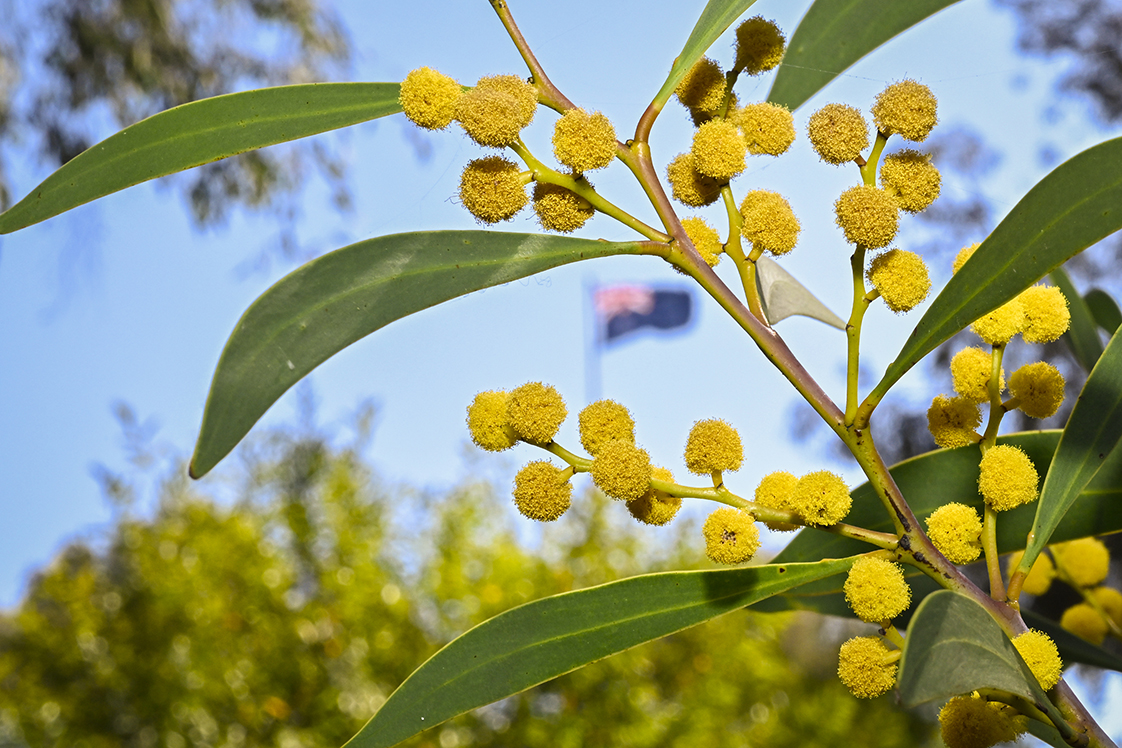National symbols in Parliament House
This fact sheet gives details about some of Australia's national symbols and where they are featured in Australian Parliament House. It explains the history and significance of Australia’s Coat of Arms, flags and floral emblem.
What will I learn?
- Australia has several national symbols.
- Many Australian symbols can be found at Australian Parliament House including the national flag, Coat of Arms and golden wattle.
Glossary words
federation, proclamation
What are Australia’s national symbols?
There are several official symbols of Australia, including flags, the Coat of Arms and golden wattle—the national floral emblem. Many of these symbols are featured at Australian Parliament House.
Coat of Arms
Coat of Arms on the Great Verandah

DPS Auspic
Description
The front of Australian Parliament House features the Commonwealth Coat of Arms above the main entrance. The Coat of Arms is made up of a kangaroo, an emu and a shield with symbols of the six Australian states. This part of the main entrance is known as the Great Verandah.
Copyright information
Permission should be sought from DPS AUSPIC for third-party or commercial uses of this image. To contact DPS AUSPIC email: auspic@aph.gov.au or phone: 02 6277 3342.
Coat of Arms on the Great Verandah

DPS Auspic
Description
The front of Australian Parliament House features the Commonwealth Coat of Arms above the main entrance. The Coat of Arms is made up of a kangaroo, an emu and a shield with symbols of the six Australian states. This part of the main entrance is known as the Great Verandah.
Copyright information
Permission should be sought from DPS AUSPIC for third-party or commercial uses of this image. To contact DPS AUSPIC email: auspic@aph.gov.au or phone: 02 6277 3342.
The Commonwealth Coat of Arms is the formal symbol of the Commonwealth of Australia. It is found at the entrance to Parliament House, inside the Senate and House of Representatives and in other parts of the building.
The Coat of Arms is used to identify the authority and property of the Commonwealth of Australia, including the Australian Parliament, Australian Government and Courts. It is used on the cover of Australian passports, other official documents and government buildings.
The first Commonwealth Coat of Arms was introduced on 7 May 1908. The second Coat of Arms was introduced on 19 September 1912. The second version is similar to the original but includes symbols of the 6 Australian states. This version is the official Commonwealth Coat of Arms.
The centre of the Coat of Arms is a shield with symbols of the states. These symbols are enclosed in a border to represent Federation in 1901, when they united to form Australia. The shield is held by 2 native Australian animals—a kangaroo on the left and an emu on the right—some say chosen because they can’t easily move backwards, symbolising a nation moving forward. The Commonwealth Star appears in gold above a band of gold and blue. There is a scroll displaying the word 'Australia' near the bottom. Golden wattle flowers form the background.
Australian flags
DPS AUSPIC The Australian National Flag, the Australian Aboriginal Flag and the Torres Strait Islander Flag are displayed on flagpoles at Australian Parliament House. Permission should be sought from DPS AUSPIC for third-party or commercial uses of this image. To contact DPS AUSPIC email: auspic@aph.gov.au or phone: 02 6277 3342.Australian, Aboriginal and Torres Strait Islander flags

Description
Copyright information
The flag was first flown on 3 September 1901 at the Royal Exhibition Building in Melbourne but was not proclaimed as the official national flag until 1953.
The flag has 3 features on a blue background:
- The Union Jack – the flag of the United Kingdom – represents Australia's historical link with Britain and continuing place in the Commonwealth.
- The Commonwealth Star has 7 points. The points represent the 6 states and Australia’s territories.
- The Southern Cross is a constellation of stars which can only be seen in the southern hemisphere.
Australia has other official flags, including the Australian Aboriginal Flag and the Torres Strait Islander Flag. Both flags were proclaimed on 14 July 1995 and are flown with the Australian National Flag in the Senate and the House of Representatives.
The Australian Aboriginal Flag is made up of three colours—black, red and gold. Black symbolises Aboriginal peoples. Red symbolises the colour of earth and ochre, which is used in ceremonies. The circle of gold in the centre of the flag represents the sun.
The Torres Strait Islander Flag contains a white dhari – a traditional dancer's headdress – which is an important symbol for Torres Strait Islander peoples. Below the dhari is a white five-pointed star—a symbol of sea navigation. The 5 points represent the island groups in the Torres Strait, and white represents peace. These symbols are on a blue background, surrounded by panels of green and black. Blue represents the sea, green represents the land and black represents Torres Strait Islander peoples.
DPS AUSPIC Wattle grow in the gardens of Australian Parliament House. The trees have thin green leaves and several small yellow spherical flowers. The yellow wattle flower is Australia’s national floral emblem. In the background of this photo, the Australian flag flies on top of Parliament House. Permission should be sought from DPS AUSPIC for third-party or commercial uses of this image. To contact DPS AUSPIC email: auspic@aph.gov.au or phone: 02 6277 3342.Wattle at Australian Parliament House

Description
Copyright information
National floral emblem
Australia's national floral emblem is the golden wattle, Acacia pycnantha. It was proclaimed by the Governor-General on 19 August 1988. The golden wattle grows in the gardens around Parliament House and is shown in wooden artworks in the marble foyer – the public entrance to Parliament House.
When in flower, the golden wattle is green and gold—Australia's national colours.
The floral emblem has been used in many official designs, including stamps, currency, awards and the Commonwealth Coat of Arms. The Order of Australia medal is designed to look like a single wattle flower.
National Wattle Day is celebrated on 1 September. It is around this time of year that the golden wattle starts to bloom.
Other national symbols
Other symbols of Australia include:
- green and gold—Australia’s national colours
- ‘Advance Australia Fair’—the Australian national anthem
- opal—Australia’s national gemstone
- The Great Seal of Australia